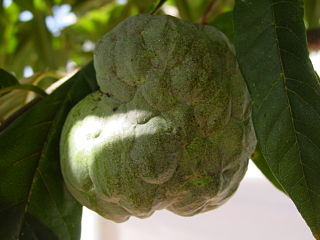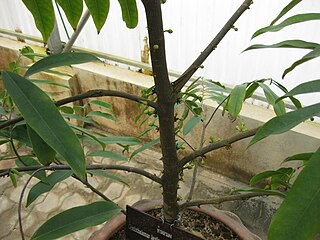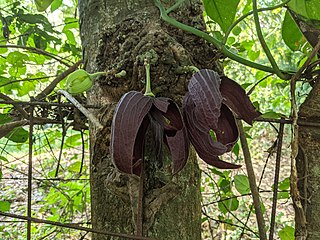
Soursop is the fruit of Annona muricata, a broadleaf, flowering, evergreen tree. The exact origin is unknown; it is native to the tropical regions of the Americas and the Caribbean and is widely propagated. It is in the same genus, Annona, as cherimoya and is in the Annonaceae family. Soursop is known as sirsak in Indonesia, where it is widely available and believed to have medicinal benefits.

The Annonaceae are a family of flowering plants consisting of trees, shrubs, or rarely lianas commonly known as the custard apple family or soursop family. With 108 accepted genera and about 2400 known species, it is the largest family in the Magnoliales. Several genera produce edible fruit, most notably Annona, Anonidium, Asimina, Rollinia, and Uvaria. Its type genus is Annona. The family is concentrated in the tropics, with few species found in temperate regions. About 900 species are Neotropical, 450 are Afrotropical, and the remaining are Indomalayan.

Annona is a genus of flowering plants in the pawpaw/sugar apple family, Annonaceae. It is the second largest genus in the family after Guatteria, containing approximately 166 species of mostly Neotropical and Afrotropical trees and shrubs.
Hexalobus is a genus of flowering plants in the family Annonaceae. There are five species native to tropical Africa.
Mkilua is a genus of plant in the family Annonaceae. It is native to Kenya and Tanzania. It contains a single species, Mkilua fragrans. Bernard Verdcourt, the British botanist who first formally described the species, named it after the fragrance of its flowers which smell like lemon. M. fragrans is monotypic. It is commonly called Mkilua Mwitu, Kilua and Kiluwa in Swahili, and Kingade in Digo. Volatile oils extracted from its leaves, flowers, and aerial parts have been reported to be repellent to Anopheles gambiae mosquitoes which are vectors for the malaria parasite Plasmodium falciparum. Bioactive molecules extracted from its roots have been reported to have antimicrobial activity in tests with Streptococcus agalactiae and Staphylococcus aureus.
Monocyclanthus is a monotypic genus of flowering plants in the family Annonaceae containing the single species Monocyclanthus vignei. It is native to Ghana and Liberia. It is a rare plant of the understory of wet evergreen forest habitat.

Orophea is a genus of flowering plants in the family Annonaceae. There are about 37 species native to Asia.

Popowia is a genus of flowering plants in the family Annonaceae. There are about 50 species distributed in tropical Asia and Africa and in Oceania.
Uvariopsis is a genus of flowering plants in the family Annonaceae. The genus is unique to Africa, and consists of about 18 species, all of which are either ramiflorous, cauliflorous or both.

Deeringothamnus rugelii is a rare species of flowering plant in the custard apple family known by the common names Rugel's pawpaw, Rugel's false pawpaw, and yellow squirrel banana. It is endemic to Volusia County, Florida, in the United States, where there are fewer than 5000 plants remaining in severely fragmented habitat. The main threat to this species is habitat destruction and degradation. It was federally listed as an endangered species in 1986.

Sirdavidia is a monotypic genus of flowering plants from the family Annonaceae described February 4, 2015, by Thomas L.P. Couvreur of France's Institute of Research for Development, Raoul Niangadouma of the Herbier National du Gabon, Bonaventure Sonké of the University of Yaoundé, and Hervé Sauquet of Université Paris-Sud. The genus was named in honor of Sir David Attenborough. The type species Sirdavidia solannona was discovered and collected in Gabon in Crystal Mountains National Park on November 15, 2013, at elevations of 300–600 meters. The species name refers to the resemblance of the flowers to those of Solanum species.

Cymbopetalum penduliflorum is a species of plant in family Annonaceae. The specific epithet penduliflorum derives from the Latin pendulus and florum (flowered).
Uvariopsis zenkeri Engl. is a species of flowering shrub in the Annonaceae family in the genus Uvariopsis, endemic to Cameroon and the Central African Republic.
Bocagea is a genus of plants in the family Annonaceae. It comprises four species distributed in Brazil. Augustin Saint-Hilaire the French botanist who first formally described the genus named it after Josephi Mariae de Souza du Bocage, who he said beautifully translated a poem about flowers into Portuguese and illustrated it.

Fusaea longifolia is a species of plant in the family Annonaceae. It is native to Brazil, Colombia, Ecuador, French Guiana, Guyana, Peru, Suriname and Venezuela. Jean Baptiste Christophore Fusée Aublet, the French botanist who first formally described the species using the basionym Annona longifolia, named it after its long-leaved foliage.

Goniothalamus laoticus is a species of plant in the family Annonaceae. It is native to Laos and Thailand. It was originally described by the French botanists Achille Eugène Finet and François Gagnepain using the basionym Mitrephora laotica. In Thailand it is commonly called Khao Lam-dong and is used as a traditional medicine.

Huberantha is a genus of plants in the family Annonaceae and tribe Miliuseae. It is distributed in Australia, tropical Asia, East Africa and some Pacific islands. Tanawat Chaowasku named the genus "Huber's flowers" in honor of the German botanist Herbert Huber and to highlight its flowers as a distinguishing feature of the genus. A number of species have been moved here from the genus Polyalthia.
Pseudoxandra lucida is a species of plant in the family Annonaceae. It is native to Bolivia, Brazil, Colombia, Peru, and Venezuela. Robert Elias Fries, the Swedish botanist who first formally described the species, named it after its shiny leaves.

Sapranthus palanga, commonly known as palanca, is a species of cauliflorous tree in the family Annonaceae, native to the tropical regions of Central America, especially Costa Rica.
Desmopsis is a genus of flowering plants belonging to the family Annonaceae.












